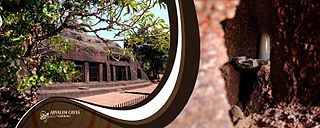
Old Goa is a historical site and city situated on the southern banks of the River Mandovi, within the Tiswadi taluka (Ilhas) of North Goa district, in the Indian state of Goa.

Panaji is the capital of the Indian state of Goa and the headquarters of North Goa district. Previously, it was the territorial capital of the former Portuguese India. It lies on the banks of the Mandovi river estuary in the Tiswadi sub-district (taluka). With a population of 114,759 in the metropolitan area, Panaji is Goa's largest urban agglomeration, ahead of Margao and Mormugao.

Ribandar is a town in Tiswadi, Goa, located between the cities of Panjim and Old Goa.

Bicholim, is a small town and a municipal council in North Goa district in the state of Goa, India. It is the headquarters of the Concelho (county) of Bicholim, one of seven that make up the Novas Conquistas, territories added to Goa comparatively later than the first three of the Velhas Conquistas. The town is located about 30 km (19 mi) from the state capital of Panaji. It is in the mining heartland of Goa.

Media in Goa refers to the newspapers, magazines, radio stations, cable and television networks and online media in India's smallest state. Over the past two-and-half decades, the Goa-linked online media has also grown.
Bastora is a village in North Goa, India. It is located on the outskirts of Mapusa town. Green and still scenic, this is one of the many communities and villages that makes up mainly-rural, but fast-urbanising Goa.
Aldona is a village in the Taluka of Bardez in the Indian state of Goa. It is known for producing several prominent Goans.

Siolim is a village in Bardez taluka, and a census town on the central west coast of India, in the North Goa district of Goa. The 2001 population was 10,311, and 10,936 in 2011. Siolim is also the name of a constituency in the Goa assembly, which includes Assagao, Anjuna and Oxel, in addition to Siolim. A person from Siolim is known as a Siolcar or even as Shivalkar.

Cortalim is a village in Morumugão, Goa, India. Its native Goan population is entirely Catholic and their main occupations include fishing and agriculture. Located on the banks of the Zuari River, it was previously known as Kushasthale.

Fontainhas is an old Latin Quarter in Panjim, capital city of the state of Goa, India. It maintains its Portuguese influence, particularly through its architecture, which includes narrow and picturesque winding streets like those found in many European cities, old villas and buildings with projecting balconies painted in the traditional tones of pale yellow, green, or blue, and roofs made of red coloured tiles. Fontainhas' heritage ambience represents the traditional Portuguese influence in the area.
Taleigão, or Platô de Taleigão, is a neighborhood located in the southern part of the city of Panaji, the capital of the Indian state of Goa. It is entirely located on the island of Tiswadi, which is one of the talukas in the state of Goa. The neighborhood is known for its important campus at the Goa University.
Raia is a quaint village in the Salcete taluka of South Goa district, Goa state, India. It is located 4 km (2.5 mi) east from the district headquarters of Margao and 35 km (22 mi) from the state capital Panjim.
Goan Catholic literature is diverse.
Captain Alvaro de Loyola Furtado BS WM OM, popularly known as Dr. Alu, was a former member of the Goa Legislative Assembly and one of the founding members of the United Goans Party. He was also a social worker, historian, journalist, medical practitioner and humanitarian. Described as a leader among men, a man of great integrity and honour.

Luís de Menezes Bragança, alternatively spelled as Luís de Menezes Braganza, was a prominent Indian journalist, writer, politician and anti-colonial activist from Goa. He was one of the few Goan aristocrats who actively opposed the Portuguese colonisation of Goa. During his lifetime, Menezes Bragança was widely hailed around the Lusosphere as "O Maior de todos" and in the Indian mainland as "The Tilak of Goa".

Piedade is an island village located in Ilhas, a northern district in the state of Goa, India, and named after Our Lady of Compassion. The name comes from the Portuguese word piedade, which means "compassion". It lies 23 km east of the state capital, Panjim, between the taluks of Satari and Ponda. Other nearby villages are Amona (3 km), Volvoi (3 km), Surla (4 km), Cudnem (4 km), Betqui, and Candola (5 km).
Goa is currently India's smallest state on the west coast, and its writers have written in many diverse languages. Poetry is a small and scattered field in the region, and this page makes an attempt to acknowledge those who have contributed to the field. It includes those listed below who have contributed to poetry in and from Goa, as well as those writing poetry in Goa. Poetry related to Goa is known to have been written in Konkani, in Portuguese, English and Marathi, apart from other regional, national and international languages to a lesser extent.
Santa Cruz Assembly constituency is one of the original Goa Legislative Assembly constituency seats in the Tiswadi Taluka of North Goa District in the State of Goa. The other constituencies in Tiswadi are Panaji, Taleigao, St. Andre and Cumbarjua.

Dr Francisco Newton João Vicente da Piedade Jaime Valfredo Rangel was a Goan doctor, Director of Tipografia Rangel, President of the Municipal Council of Bardez and a delegate to the International Labour Organization for Portugal.



















